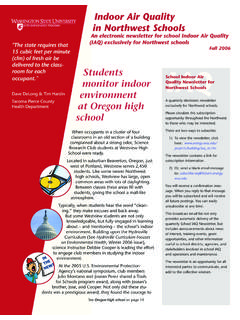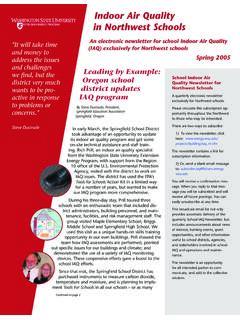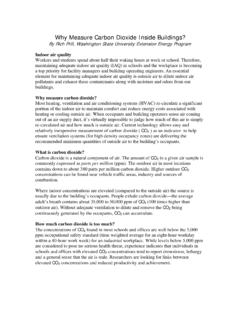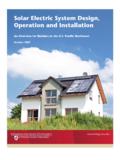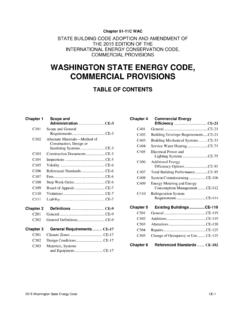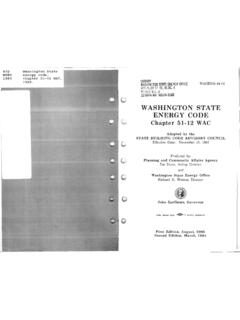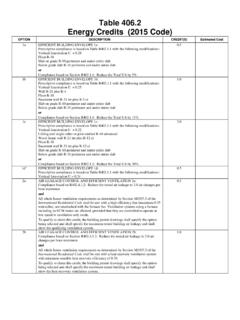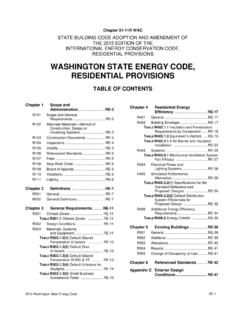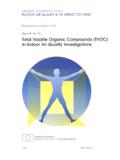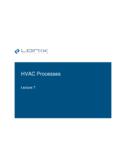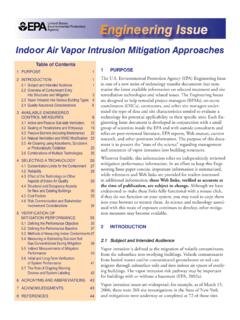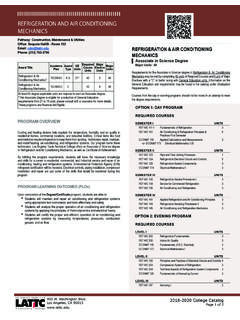Transcription of Measuring Carbon Dioxide Inside Buildings – Why is it ...
1 Measuring Carbon Dioxide Inside Buildings Why is it Important?Our MissionTo advance environmental and economic well-being by providing unmatched energy services, products, education and information based on world-class research. About Us Our staff of over 100 people (energy engineers, energy specialists, technical experts, software developers, energy research librarians, and more) work out of our Olympia, Spokane and satellite offices. Operating similar to a consulting firm, the WSU Energy Program is a self-supported department within the WSU We are part of the College of Agricultural, Human and Natural Resource Sciences. We report directly to the WSU Vice President of Agriculture and PrillBuilding Science & Indoor Environmental Quality quality of air Inside a building depends on the concentrations of contaminants such as gases and particles and how much fresh air is brought into the building through its ventilation system to dilute and remove these pollutants.
2 It is essential to monitor indoor air quality (IAQ) to provide for occupant health, productivity and comfort. This factsheet: Explains how Carbon Dioxide (CO2) levels in a building can be used to monitor IAQ and the ventilation rate. Provides guidance about accurately Measuring CO2 the companion factsheet, Good Ventilation is Essential for a Healthy and Efficient building , * to learn about how much fresh air should be brought into a building to keep the environment healthy and comfortable without using excessive CO2 levels as an indicator of IAQThe complex mixture of gases and particles in indoor spaces is difficult to measure. However, CO2 levels, which are easy to measure, can be used in place of other measurements to indicate IAQ.
3 * Available on the Washington State University Energy Program website: is produced when people breathe. Each exhaled breath by an average adult contains 35,000 to 50,000 parts per million (ppm) of CO2 100 times higher than is typically found in the outside air (OSA).The CO2 concentration in an occupied indoor space indicates if the building s air exchange balance is appropriate that is, if the optimal amount of OSA is being mixed with air that has been circulating in the building . Using a CO2 meterA CO2 meter lets you easily and inexpensively measure CO2 levels in specific areas of your building . But, because the outdoor CO2 concentration is included in the amount of CO2 indoors, you must measure outdoor CO2 levels when assessing indoor concentrations.
4 Outdoor CO2 levels are typically around 380 to 500 ppm. Most CO2 meters are accurate enough to indicate if ventilation in offices and schools is adequate. Some of these instruments measure only CO2; others simul-taneously measure temperature, relative humidity and other gases, such as Carbon monoxide. A new generation of CO2 monitors can measure volatile organic compound concentrations and infer CO2 concentrations from these measurements. Instruments that record data internally or are coupled to an external data logger (as opposed to only giving instant readouts) provide valuable data for identi-fying trends, trouble-shooting and verifying solutions. How much CO2 is too much?Current ventilation guidelines, such as those from the American Society of Heating Refrigerating, and Air Conditioning Engineers (ASHRAE), recommend that indoor CO2 levels not exceed the local outdoor concentration by more than about 650 ppm.
5 Good practice indicates that the ASHRAE Standard target CO2 level in indoor air is about 1,030 ppm, as follows: 380 ppm CO2 typically found in OSA+ 650 ppm CO2 (ASHRAE target maximum level) = 1,030 ppm CO2 (ASHRAE maximum recommended indoor level of CO2)It is important to adhere to these guidelines. The performance of individuals in schools and offices with elevated CO2 concentra-tions can be affected because occupants may become lethargic and drowsy. Additionally, as CO2 builds up, so do other indoor air contaminants, which increases occupants exposures to irritating, distracting and potentially unhealthy gases and indoor CO2 measurementsInterpreting CO2 data is often a more significant source of error than instrument accuracy.
6 Meaningful assumptions about ventilation rates based on CO2 values require that the building or zone be occupied long enough to allow the CO2 levels to reach a balance with the ventilation rate. This balance is known variously as equilibrium, unity or steady-state. In an occupied building with a very low ventilation rate, the CO2 levels will likely increase throughout the day, What is CO2?CO2 is a natural component of the atmosphere. The amount of CO2 in an air sample is expressed as parts per million (ppm) the number of CO2 molecules per million molecules of air. The CO2 levels in the air outside a building are usually 380 ppm or higher, depending on: Local conditions vehicle traffic, industry and other sources of combustion.
7 Weather conditions wind and temperature inversions can cause combustion gases to build up in a local area. An elevated indoor CO2 concentration is directly related to the number of occupants in the building , the building s ventilation rate, and the CO2 level in the outside CO2 can accumulate if ventilation is not adequate to dilute and remove the CO2 that is continuously generated by building occupants. never reaching a steady-state concentration. Conversely, a high ventilation rate and good mixing of OSA may prevent CO2 from accumulating much beyond outdoor levels, so CO2 concentra-tions stay low throughout the day. Unless equilibrium has been reached, CO2 measurements will not accurately reflect the building ventilation rate.
8 For example, if a CO2 measurement is taken in a classroom during the first class of the day, CO2 will not have accumulated to the point where equilibrium has been reached. Therefore, OSA ventilation rates based on this CO2 measurement will be overestimated. If a CO2 measurement is taken in the same classroom at the end of the day and the room s ventilation rate and occupancy have remained fairly consistent throughout the day, it is reasonable to assume that CO2 equilibrium has been reached. Assumptions about OSA venti-lation rates based on this CO2 measurement will likely be useful for estimating the ventilation rate. However, errors in CO2 measure-ments do occur, often caused by: Ventilation systems that modulate the amount of OSA allowed into the building over the course of a day, Occupancy rates that fluctuate significantly, Instrument or calibration problems, Measurement location, and/or Poor mixing of the air within the space.
9 Using CO2 monitors to automate fresh air ventilationOnce you have evaluated the building s ventilation system and determined if adjustments are necessary, consider installing CO2 sensors to continuously monitor the CO2 levels in the building . The HVAC control system can use the CO2 values to automatically modulate the volume of OSA that is brought in so indoor CO2 is maintained at or below a preset target concentration. This strategy is known as Demand Controlled Ventilation (DCV). DCV systems are especially useful for spaces that experience variable occupancy rates, such as cafeterias, gymnasiums, classrooms and conference rooms, because the ventilation rate changes automatically in response to changes in the occupancy systems with CO2 control sensors have been demonstrated to save 5 to 27 percent** of HVAC energy usage in a typical office environment, depending on occupancy type and use.
10 Savings can be even greater when DCV is installed in spaces with high variability in occupancy, such as conference rooms, cafeterias and gyms. It is relatively inexpensive to install CO2 sensors, and they usually bring a very attractive return on investment. These sensors cost between $500 and $5,000, depending on their features:** For an HVAC system that has an air-side economizer with a motorized damper already installed in the OSA duct, the cost of adding CO2 sensors will be close to $500. For HVAC systems that need to have a motorized damper added to their outside and return air ducts, along with the associated controls, the cost of adding CO2 sensors will be measurements are useful to help you: Determine if a building has adequate ventilation.
